| Home |
| Books |
| Biography |
| Teachers |
| Kids |
| Questions |
| Blog |
| Contact |
| Events |
Wondering While Wandering
Toads!
April 12, 2014
Today we were looking for a nice spring walk, while so many blossoming trees are at their peak. We headed to the Schoolhouse Pond, which never disappoints. As we approached, the air rang with spring time voices of amphibians calling out to each other. We greeted the sentinel heron, standing guard on the wood duck box and followed the trilling to the outlet creek at the east side of the pond. Toads!I stopped counting at 40. Most of them were reddish brown, but some were darker. We could see their striped legs as the kicked and climbed. Arrayed along the banks and in the water, coming together, moving apart, climbing aboard one another, holding on, kicking away. Tons of toads! One rested on the back of a painted turtle. We enjoyed their trills as we walked around the pond.I didn't have my camera, but they looked a lot like this. After such a frog-poor year at Watkins Park in 2013, it's good to see these toads working on the next generation.
A Birding Adventure
Here's a photodocumentation of a phenomenon that I've witnessed at least twice before and described in "My Adventure as a Birder." On December 24, 2009, I walked around Schoolhouse Pond in Upper Marlboro with my daughters. The pond was covered with ice which was covered with birds, mostly seagulls, with scattered Canada geese, mallards and Northern shovellers. Suddenly, the birds were in the air. This was nothing like the sudden flight of starlings who fly in formation, tilting and whirling at identical angles in a tightly choreographed display with audible wing beats. Instead, this crowd took to the air in silence, and separately, not together, much more like swirling snowflakes than well-rehearsed dancers. Watching them float in random loops and circles over our heads seemed so magical I almost forgot to look for what set them off.
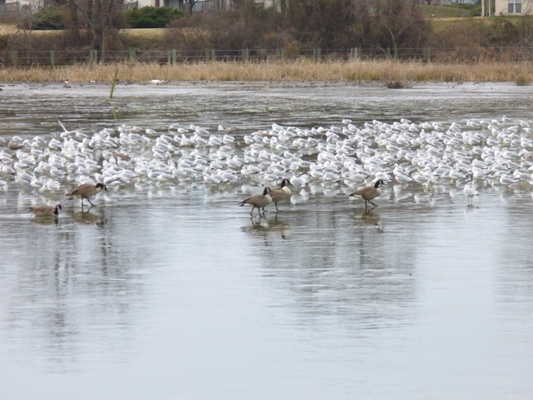 | 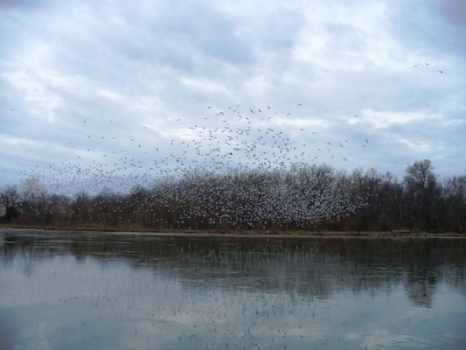 |
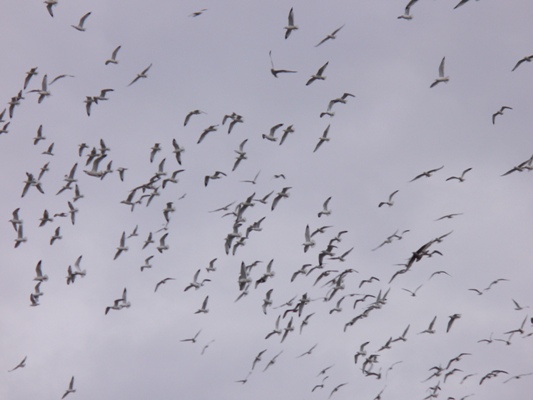 | 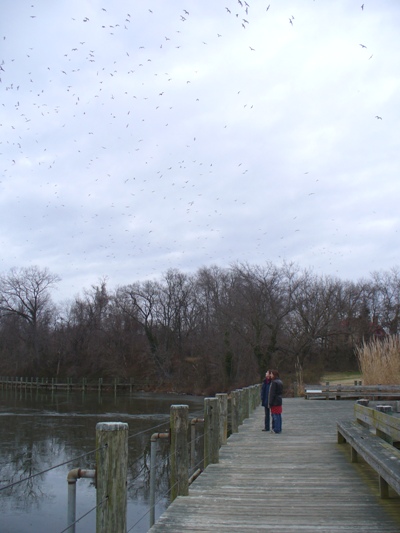 |
In the quiet, a bald eagle winged its way over the pond and took a perch in a tall tree above the boardwalk. I know that local eagle populations have increased greatly in recent years, but I'd never one seen at this pond before. Even if they were as common as dirt, they'd still take your breath away.
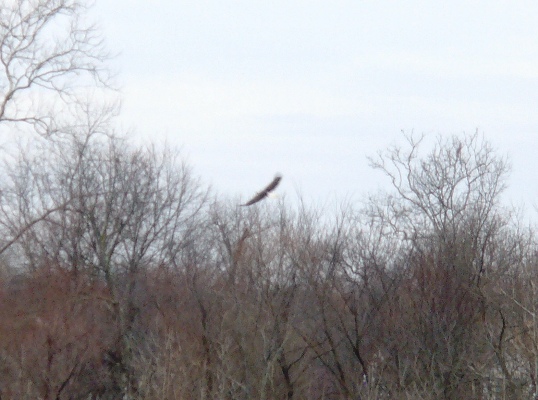 |  |
The regular denizens of the pond knew better than to act like "sitting ducks" with that broad wingspan casting a shadow on the ice. Only the great blue heron stood his ground, unperturbed. After some watchful waiting in his perch, the eagle took off and looped around the pond again. Then, finding no easy pickings he alit in tree above the observation deck. There he sat, calmly surveying his kingdom. The ducks and geese gradually reappeared on the open water. The swan stayed on alert. The gulls stayed away.
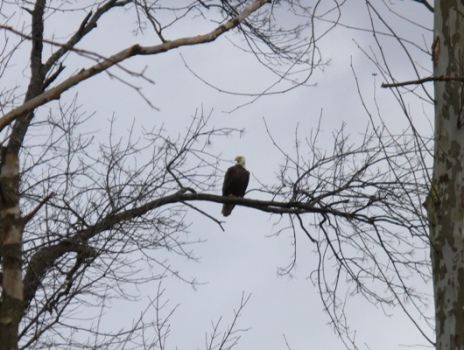 |  |
2009: The Year to Take Time for Books
In the Washington Post Outlook Section on Sunday, December 21, 2008, Carleen Brice proclaimed that December is “Buy a Book by a Black Author and Give it to Somebody Not Black Month.” Even while she suggests ("with tongue firmly lodged against cheek") a campaign for race-based buying, Brice points out the irony in the establishment of African American sections in book stores. Of course, books in stores and libraries need to be sorted so that people can find them easily. That’s why there are systems that discriminate based on topic, genre, and alphabetical order. But, really, should we segregate books on the shelves by race? Doesn’t that just seem wrong?
Okay, maybe I have a personal agenda here. Maybe I want more readers to find my book too. Finch Goes Wild tells the story of a good middle class kid working to become his best self in spite of other people’s expectations, just like so many of the real kids I’ve known as a pediatrician and a teacher. The protagonist is African American. The author is not. Before the book got its cover, readers sometimes got half-way through the book before suddenly realizing: “Hey, wait a minute, is this kid black?” Readers of various hues have enjoyed getting to know my hero, Harmon Finch. His story is daringly wholesome, featuring band geeks, bird watchers and standard English grammar. (Yes, Virginia, there are black lives that are not dominated by pimps, drugs and gangs.) When Harmon gets to experience a wider world, he finds that his own decisions determine his destiny. Finch Goes Wild is a nice little book. It was honored with the AfrAm Literary Award for Best Young Adult Title of 2007. Still, sales could be better.
Actually, it’s not just my book that isn’t selling. The whole book industry is suffering. The number of independent publishers and booksellers continues to dwindle, even while many new literary voices clamor to be heard. Even the big players of the publishing world find the need to cut back and reorganize. So many thoughtful, interesting, insightful - even exciting - books sit gathering dust while people spend their time and money on electronic gadgets.
By giving us a unique window on what other people think, books can expand our view of the human experience. Reading works by and about people who are different from ourselves increases understanding, nurtures tolerance and deepens our capacity for empathy. So sure. Save your local bookstore! Feed a starving author! Support your local library! Share interesting ideas and new perspectives with people you care about! Buy books. Give books. Share books. Read books. Talk about books--lots of books about lots of different kinds of people. But please, don’t limit your choices based on race. And why limit your book-buying to December? Make 2009 your year to “Take Time for Books.” When you find one that stretches your brain and expands your world view, spread the word.
Preparing for Winter
December 14, 2008
 “Partly sunny, high of 52,” it says in the paper. However, in the park today, it’s bleak and oh-so December. Grey, grey, grey. The holly is a bright spot—still green, with more berries than usual. Last month, Brigid Schulte reported in the Washington Post that local oak trees haven’t produced many acorns this year. I wonder if the squirrels who can’t find acorns will eat those holly berries instead. Do cyclic changes in fruit and nut production contribute to biodiversity by providing checks and balances to population growth of the various species who share our neck of the woods? No sooner had this interesting question popped into my head than it was displaced by another: What does the park maintenance crew think they are accomplishing with that horrid leaf blower? Its grating scraping and whining blasts out through the woods disturbing the peace. I feel my soul cringe and my brow crease. There’s no escaping it. Forget about listening for the rustle of leaves or the drumming of woodpeckers. Even the Carolina wren can’t be heard through that racket. Pollen and mold spores that have silently rained down get dislodged from their resting places and hurled back into the air along with the carbon dioxide and assorted noxious gases emitted from the leaf blower. For what? Just to move a few errant leaves from the paved path a few feet over to the forest floor.
“Partly sunny, high of 52,” it says in the paper. However, in the park today, it’s bleak and oh-so December. Grey, grey, grey. The holly is a bright spot—still green, with more berries than usual. Last month, Brigid Schulte reported in the Washington Post that local oak trees haven’t produced many acorns this year. I wonder if the squirrels who can’t find acorns will eat those holly berries instead. Do cyclic changes in fruit and nut production contribute to biodiversity by providing checks and balances to population growth of the various species who share our neck of the woods? No sooner had this interesting question popped into my head than it was displaced by another: What does the park maintenance crew think they are accomplishing with that horrid leaf blower? Its grating scraping and whining blasts out through the woods disturbing the peace. I feel my soul cringe and my brow crease. There’s no escaping it. Forget about listening for the rustle of leaves or the drumming of woodpeckers. Even the Carolina wren can’t be heard through that racket. Pollen and mold spores that have silently rained down get dislodged from their resting places and hurled back into the air along with the carbon dioxide and assorted noxious gases emitted from the leaf blower. For what? Just to move a few errant leaves from the paved path a few feet over to the forest floor.
It's coming on Christmas. They're cutting down trees.
They're putting up reindeer, singing songs of joy and peace.
Oh, I wish I had a river I could skate away on. --Joni Mitchell
Harmon Makes Friends!
May 27, 2008
At the 2008 Afr'Am Fest in Norfolk on May 25, Finch Goes Wild was awarded the Afr'Am Literary Award for "Best Young Adult Title of 2007." I am truly honored to have my work recognized by the Southeastern Virginia Arts Association as part of their "Reading is a Family Affair" campaign. I hope this acknowledgement will help more young people see that their own stories are worth telling, and that they can learn a great deal by looking at the world through other people's eyes.
Notes from Becca's Backyard: Developing Core Math Skills Without Math Anxiety
March 14, 2008
A summary of a new report from the National Mathematics Advisory Panel in today's Washington Post. It says that "students need a deeper understanding of basic skills, including fluency with whole numbers and fractions." Does this surprise anybody?
This week as I was teaching my community college students about how to use the information on food labels to make good eating decisions, I again watched the "I don't do math" curtain fall across their faces. ("Who, me? Manipulate numbers and understand what they mean? Forget about it.") But these people want to be nurses and pharmacists and respiratory therapists. What will happen to their patients if they don't know where to put the decimal point, or if they can't recognize that a measurement is significantly out of line?
Quantitative reasoning is not just for students who will become scientists and engineers. The number sense and logical thinking that emerges when kids master core math skills enable them to make better decisions in all walks of life. Which laundry detergent is the better buy? Is this sub-prime mortgage a good idea? What does the doctor mean when she tells me that six out of ten people who take this antidepressant get better? Understanding what numbers mean is essential as we evaluate our options every day.
Too often, kids get to a point where math seems "hard," and they just stop doing it. How can we help them get past those rough patches and contimue to develop their quantitative reasoning skills? Teachers need to help kids succeed by giving the right lesson at the right time. When they spend enough time practicing basic skills and applying those skills to problems of everyday life, they can discover all kinds of interesting things about numbers. I hope that reading about Becca in Danger: Long Division will help to inoculate kids against the math anxiety that paralyzes so many young adults.
Close encounter in Harmon's Woods
February 24, 2008
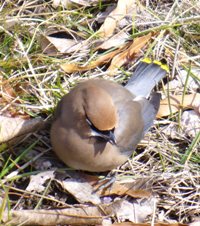 As I walked home from the little park where Harmon threw sticks for Bud, a smallish brownish bird flew close overhead, leaving me wondering: What was that flash of yellow? Flicker? Too small, no white rump. Goldfinch? I've never seen one land on the ground like that, right between the sidewalk and the street? A mockingbird flew out of a dormant crabapple, landed next to the little bird, hopped twice and flew off. Why didn't the little bird fly off too? I approached quietly and stood right over it. It looked headless, and too still, but it breathed. The bright yellow tips of its tail feathers spread in a neat row on the greening grass. Its brown head was tucked under its wing, all but hiding its mask. A cedar waxwing, all alone and plum tuckered out. I stood guard for a few moments, wondering what would happen if one of those stray cats that prowl the neighborhood came by. I went home, got my camera, and returned to see it hopping on the grass. As I approached, it flew up to the branch of a cherry tree. Expecting it to fly off any second, I took a picture from too far away, and then crept forward. It returned to a different patch of grass between sidewalk and tree, breathing heavily. It opened its beak, panting. I could see the red inside its mouth. Then it hunched its head between its shoulders and let me take its picture before it flew across the street to take up a perch on the neighbors' flower box. Good luck, little guy. Get some rest. Hope you can find your flock. And watch out for those cats.
As I walked home from the little park where Harmon threw sticks for Bud, a smallish brownish bird flew close overhead, leaving me wondering: What was that flash of yellow? Flicker? Too small, no white rump. Goldfinch? I've never seen one land on the ground like that, right between the sidewalk and the street? A mockingbird flew out of a dormant crabapple, landed next to the little bird, hopped twice and flew off. Why didn't the little bird fly off too? I approached quietly and stood right over it. It looked headless, and too still, but it breathed. The bright yellow tips of its tail feathers spread in a neat row on the greening grass. Its brown head was tucked under its wing, all but hiding its mask. A cedar waxwing, all alone and plum tuckered out. I stood guard for a few moments, wondering what would happen if one of those stray cats that prowl the neighborhood came by. I went home, got my camera, and returned to see it hopping on the grass. As I approached, it flew up to the branch of a cherry tree. Expecting it to fly off any second, I took a picture from too far away, and then crept forward. It returned to a different patch of grass between sidewalk and tree, breathing heavily. It opened its beak, panting. I could see the red inside its mouth. Then it hunched its head between its shoulders and let me take its picture before it flew across the street to take up a perch on the neighbors' flower box. Good luck, little guy. Get some rest. Hope you can find your flock. And watch out for those cats.
More notes from Harmon's Woods: Using Young Adult Fiction to Teach Tolerance
Thursday, February 7, 2008
Ethan Oppenheimer, the hero of Pamela Ehrenberg's young adult novel, Ethan Suspended has never met Harmon, but they are kindred spirits -- young musicians seeking harmony in a world of discord. If you haven't met Ethan yet, you really ought to.
Early adolescents can get so locked into their own egocentric view of the world. One good way to stretch their brains is to get them to see the world through the eyes of somebody who is different from themselves. Fiction can help.
Ethan Suspended is a great example of story that can promote understanding across ethnic divides. Diverse people in this story, both young and old, come to better understandings of each other through ordinary, everyday interactions. As Ethan gets to know people who come from outside his previous comfort zone, readers grow along with him in their realization that these folks are human beings too. Felix and Daron and Diego and Sharita are all people that Ethan would never have hung out with during his previous life in Maple Heights, PA. Gangs, drug dealing, parents who make kids miss school to babysit--all that stuff is way outside Ethan's experience. But when he moves to DC to live with his grandparents, he finds regular kids dealing with this stuff on a daily basis. His grandparents seem like they are from a different planet, but as he understands them better, they become real people to him too. As Ethan's mind gets broadened, so does the reader's. It's a great vehicle for teaching tolerance.
I just had the pleasure of listening to a discussion of whether Ethan Suspended should be considered a Jewish book. What makes a book Jewish? Certainly, I'm no authority on this, but that doesn't keep me from having an opinion.
Here's a book by a Jewish author featuring Jewish characters whose decisions are informed by Jewish values. The grandparents seem a lot like other Jewish grandparents I have known -- my own kids' grandparents, for instance -- but they're not that different from other non-Jewish grandparents I've known. You know how Ethan's grandmother wipes off his face using a spittle-moistened thumb? My mother used to do that to me, and she wasn't Jewish. We see that this family has a lot of values which could be considered "Jewish," but they aren't exactly "observant." Ethan's diet in Maple Heights included non-kosher foods. The dietary differences in his grandparents' home seem more due to age than due to culture of religion. While they don't celebrate Christmas, we don't see them celebrating any Jewish holidays or keeping the Sabbath. Still, there are probably lots of Jewish kids these days who are just like Ethan, not really connected to the "old ways," but not feeling like they are totally part of the mainstream either. Ethan does a mitzvah when he warns Diego that he is in danger. He does his best to atone when he feels that his actions have resulted in harm to Daron. He helps to organize his peers to do good in his community. His decisions to do these things all seem to be informed by Jewish values. Furthermore, the "stranger in a strange land" theme is part of the archetypal Jewish experience. So, I have no trouble seeing this books as a "Jewish" book.
However, I do have a problem with labeling books and categorizing them according to their ethnicity. We shouldn't build ghettoes in our libraries -- Christian books here, Jewish books there, black books here, white books there. I consider it offensive that our local library, for instance, shelves all the "black interest" books together, separate from the rest of the collection. Puh-leez. There are way too many white folk who would never take a book off the shelf of black books, and way too many black folk who let other people limit their book selections. If the books are integrated, the people are more likely to stumble upon books that will help them see life through the eyes of someone different from themselves. This is one great hope for promoting better understanding. I wonder how my own world view would be different if I had not stumbled upon the works of Chaim Potok and Leon Uris as a teenager.
Through novels, people can find out what other people think. If you put Ethan Suspended on the "Jewish" shelf, then non-Jewish kids won't think it's for them. And it is. It's for everybody. Sure, Jewish kids of today will relate to Ethan, and their parents and teachers will consider this book "suitable." But also, reading Ethan Suspended can give non-Jewish kids a look at what's going on in a Jewish kid's head. They can see kids like themselves through the sympathetic eyes of a somewhat puzzled stranger. This is important. This is why even if Ethan Suspended qualifies as a "Jewish" book, I would argue against labeling it that way so that it will be read by lots of different kinds of kids. After all, it's really about tolerance. Put it on the shelf right next to Finch Goes Wild.
More notes from Harmon’s Woods: Sepia Tones
Sunday, December 9, 2007
Today the woods could be a sepia print. Most of the leaves are litter now. Just a few beeches and oaks still cling to their faded browns. After a few minutes awash in brown that blends into grey—grey trunks, grey mist, grey sky--eyes adapt. Green sensors detect those lichens that that won't let go of the tree trunks and mosses bright beside the asphalt. The Carolina wren shouts a welcome. The chickadees and nuthatches harmonize as a woodpecker adds a counterpoint. In a few hours, they'll turn on the Festival of Lights. Cars and carols will take possession. But now the woods is ours.
More Notes from Harmon's Woods: Earth Exhales
Sunday, October 28, 2007
We thought it would never rain again, but it did, for four days straight. The trees shiver with new vigor, even as their green goes gold. Kicking through the leaf litter, looking up at the blue sky through the thinning leaves, I can't help thinking about carbon dioxide. As the temperate forests of the northern hemisphere shed their leaves, these trees will stop taking the carbon dioxide out of the atmosphere. Those leaves, decomposing or possibly raked up and burnt, will return carbon dioxide to the atmosphere. Meanwhile, as the temperature drops and days shorten, we will burn more fossil fuels to heat and light our homes. So, as the weather gets colder, greenhouse gases shift. The earth exhales. I wonder: If average temperatures go up, will the trees keep their leaves longer? Or will they fall sooner because of lack of soil moisture.
In today's Washington Post there's a story about a guy on a hunger strike, fasting until the Congress goes home to call attention to the climate change crisis. Reporter Dan Zak wisely asks, "Speaking for people who don't have the fortitude to fast, what can we do?" And this guy goes on about bringing pressure to bear on legislators, joining organizations and speaking up. Well yeah. But what does all that hot air do to the greenhouse gases? Maybe the lack of fuel for his neurons made him miss this important opportunity to put across the real answer: Drive less. Drive slower. Turn the thermostat down and put on a sweater. Shower for two minutes instead of ten. To see the fall foliage, don't get in that SUV and drive for two hours but stay home and enjoy your neighborhood park. We can't wait for the slow wheels of democracy to do what we need to do. It's not about making other people make new rules. It's about taking greenhouse gases into consideration in the myriad little decisions we make about how we live our lives. For more things we can all do to decrease our contribution to greenhouse gases, go to www.climatecrisis.net/takeaction/whatyoucando
Notes from Harmon’s Neighborhood
Saturday, September 08, 2007
"Looks like we got Trouble. Right here in River City. With a capital T and that rhymes with P and that stands for ..."
--The Music Man
Last week the denizens of Harmon's neighborhood met to discuss concerns about undesirable activities going on the in neighborhood park—illegal sales being transacted from cars with DC plates, evidence of illegal substance use hidden in the shrubbery. Cars racing, motors revving at all hours. Derelict properties inviting trouble. It was standing-room-only, with representatives from the county police, the park police and an assortment of leaders of local home owners associations as well as The Neighbors. The police chief said they'd increase police presence gave the people advice about "what to do if..." I wondered if I'd portrayed a fantasy world in "Finch Goes Wild."
But then a young man, who looked a lot like Derek, took the floor. He said that he might be a young person, but he also has an interest in making sure this neighborhood safe for his little son. And if people thought his music was too loud, they could just ask him to turn it down. Another elder spoke my thoughts: See? Just because they are young and male doesn't mean they are criminals.
Another young man, Harmon's age, addressed the room crowded with adults, asking why the basketball backboards had been removed from the park, and would they be replaced. Renovations are underway, he was told.
Police promised faster response times and better enforcement of minor violations. Community leaders admonished the populace to talk to their own children about activities in the park and to live by the "Fixing Broken Windows" principle.
Yesterday, September arrived. That cool promise of autumn replaced the dog days of summer. All along the street, neighbors mowed lawns and trimmed shrubs. A family walked along the sidewalk, pushing a baby in a stroller. People talked with each other. A group of middle schoolers came by with petition about the basketball court. As I added my name to the list, I thought, "Yes! We will take back that park." Those boys can play basketball and Harmon can throw sticks for Bud to chase.
Inspired, I didn't quit when I finished mowing the lawn. I ripped and pulled until I got all of that kudzu off my threatened red bud, amelanchier and rose-mallow.
Sharing a world view
August 22, 2007
I write contemporary fiction for young people. My characters are good kids who struggle with making sense of the world. Sometimes they are confused. Sometimes they are sad. Sometimes they are angry. As I write them out of the jams they get into, I see that they do the best they can to muddle through the everyday dilemmas they face without the aid of superpowers of magic wands. They grow. They find a better way to relate to a complex world.
How realistic should realistic fiction be? I've been thinking about this as I read the postings on KL Going's forum concerning a parental complaint about "bad words" in her wonderful book, Fat Kid Rules the World. In my own books, my characters deal with some heavy issues, but I've kept the language "inoffensive" purposely so that parents can feel confidant that their preteens can read my work without being "contaminated." Just because your favorite 10-year-old reads "on a tenth grade level," doesn't mean they are ready for the edgy young adult works that are appropriate for older readers.
What kind of world do we present as the "real world"? When I go on a walk through Harmon's woods, I can pay attention to the candy wrappers littering the trail, the poison ivy and the dog "scat," or I can pay attention to the flight path of the birds, the intricacy of a spider's web, the feel of the cool mist, and the tilt of a tree trunk among a tangle of vines. When I look at a young person's face, I can count the zits, or I can read the angst and the yearning. How we filter the details of the world changes our world view.
As fiction writers select details to include in our works, we share our world view with our readers. I wonder: How does a young person's world view affect his vision of his place in the world? While we have a reader immersed in our pages, can our different view of a better world nurture more positive attitudes?